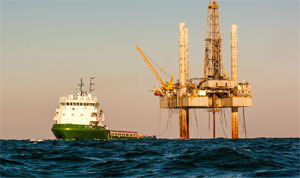The crash in global oil prices is putting the squeeze on producers in North America, who have responded by idling rigs and canceling new projects. That has led to the threat of layoffs in the U.S. maritime industry.
Uncertainty over how low prices might go and how long the slump will last is weighing on a sector that benefited greatly from the domestic energy boom after the Great Recession.
With oil prices falling from more than $100 a barrel in January 2014 to less than $50 a barrel in February 2015, Gulf of Mexico producers have cut their offshore rig counts. As a result, demand for service vessels and crews is slowing down, said Glen Ghirardi, owner of Ghirardi Marine Agency LLC, a mariner job placement service in Morgan City, La.
“There’s a fear factor out there,” Ghirardi said. “I’m hearing from (the operators) that they’re having a much more difficult time keeping their boats working. There are so many boats tied up that that there’s not enough places to park all the boats.”
In the week ended Jan. 30, the oil rig count in the Gulf of Mexico was down by six to 37, a 14 percent drop, while the number of gas rigs held steady at 10, oilfield services company Baker Hughes said. Trade publication Rigzone predicted that jack-up rig utilization in the Gulf will fall below 50 percent in 2015.
Vessel operators servicing deepwater rigs likely will be less affected. Companies investing in those multimillion-dollar projects are taking a long-term approach and are less influenced by periodic market swings.
“The reason is, deepwater is so expensive,” said Jim Russo, founder of FuelGuru.com. “From the original science it takes to find (oil) and produce it — you’re looking at a mile or two miles down — the technology is so expensive that you cannot afford to get in and out of it like a small producer from Texas could.”
Ghirardi, who provides licensed captains, mates and engineers, said shallow-water rigs are being taken out of service at a faster rate than the usual seasonal slowness.
“It’s definitely worse now than it normally is,” Ghirardi said in February. “Smaller utility boats, crew boats, that’s what’s taking a hit right now. A lot of these jack-up companies are laying off.”
Many operators, large and small, are preparing for the possibility of an extended downturn. Jeffrey Platt, president and chief executive of New Orleans-based Tidewater Inc., said the offshore services provider did not expect a “meaningful” recovery until late 2016 or early 2017.
“Our clients are under intense financial pressure due to the collapse in global oil prices and they are responding as they have in every other similar period — cutting capital spending, reducing overhead costs by cutting staff, pressuring their service company providers for lower rates and deferring projects,” Platt said during a quarterly earnings conference call on Feb. 9. “How long this environment is likely to last is a question that everyone is struggling to answer.”
Quinn Fanning, Tidewater’s chief financial officer, said average day rates for the company’s vessels would likely follow the market down over the next couple of quarters. Day rates were down 3.5 percent during the third quarter of fiscal 2015, with the company posting a net loss of $160.7 million for the period.
“As was the case in previous downturns, our task in the currently deteriorating market will be to maximize our fleet utilization and, when necessary, trade things for things — other than things for promises — in our discussions with key customers,” Fanning said. He added that Tidewater aimed to “bring our head count and cost structure in line with the current expected activity levels.”
In December, Excelerate Energy postponed its plan to establish a floating liquefied natural gas (LNG) terminal at Lavaca Bay, Texas, citing uncertainty generated by the oil price slump and the global energy glut. In Canada, Husky Energy delayed a decision on investing $2.4 billion to extend its West White Rose oil field, located about 200 miles off the coast of Newfoundland. Chief Operating Officer Rob Peabody said the company was committed to mid- and long-term projects but was prioritizing its capital in favor of quick returns.
For shipbuilders, demand remains strong for tank barges despite oil’s downturn.
The outlook for offshore supply vessels is cloudier. While many yards have OSV contracts in hand, the volume of work beyond 2016 is open to debate if oil prices stay low and offshore budgets suffer.

